| My interest in knifemaking stems from the ability to choose all the materials used and control the myriad processes required to complete a knife and sheath-and the steel available intrigues me most.
I use only parricle metallurgy stainless steels for my hunting and camping knives (CTS XHP, CPM S30 and CPM 154). These represent an excellent combination of edge-holding, abrasion resistance, toughnes, stain resistance, and hardness. 440C stainless steel has been called the "wonder steel" of the 1970s. 154CM and its Japanese equivalent, ATS34 were the wonder steels of the 1980d and 90s and now the particle metals are the choice. For kitchen knives, I use AEB-L, a fine-grained hardenable stainless steel used in the razor blade industry.
At the present time, the "wonder steel" of the new century is that made by powder metal technology whatever the proprietary name. Crucible Industries calls it CPM (Crucibal Particle Metallurgy and Carpenter steel just calls it powder metallurgy. Both are similar processes that ensure even distribution of carbides throughout the steel. Upon cooling of non-powder metals, high alloy steel carbides (from chromium, molybdenum, or vanadium) tend to congregate together in microscopic clumps, leaving small areas devoid of carbides. The powder metallurgy process remedies that issue so the carbides are evenly distributed throughout the steel. That process creates a steel that functions significantly better than the same alloy without that process.
I heat treat my own knife blades using a computer-controlled furnace designed for knives carefully following the heat-treat formula for each steel developed by the steel company engineers. I use the plate-quench method to rapidly cool the blades after reaching and soaking at the proper quenching temperature. My aluminum plates are 1 1/2 inches thick and are able to very quickly take the heat out of the blade. After they are quenched, I immerse each one in liquid nitrogen to more fully complete the transformation from austenite to martensite. Complex stainless steels (in contrast to high carbon steels) resist complete transition to the finer-grain structure, so freezing the blades assists that process. After reaching room temperature, I immediately double-temper them to the recommended optimal hardness for each steel. I have a Rockwell hardness tester and test each blade 3 times; once after the initial plate-quench, again after the cryo, and finally after the double temper. I am somewhat obessive-compulsive about the selection of steel and its heat-treatment, which, in the long run, benefits the users of my knives.
I have had the privelege of knowing and studying knifemaking with some of the greatest knifemakers in the country. Early in my knifemaking interest whil teaching at Michigan State University, I spoke with Bob Loveless, Ted Dowell and Jimmy Lile about how to properly learn the craft. They told me to contact a fantastic knifemaker in my own backyard---that was Mike Leach of Flint, Michigan. He agreed to teach me his process if I would invest in a tool of my choice (belt grinder or other significant tool) that would allow me to grind the primary bevels in a knife. He had designed and patented a centerless grinder that did just that. I chose to purchase one of his machines. i still use that wonderful tool today and still have the original wheel despite having ground hundreds of blades on it. It is a marvel of invention, a high-quality machine that is highly efficient. Mike was a wonderful teacher and mentor to me, and he and his wife are family friends of ours. I will never forget the Detroit Gun and Knife Shows at the 8-Mile Armory where Mike always wore his cowboy hat and displayed his exceptional creations. I found it difficult to get to him to talk to him because he always had someone at his table. I cannot thank him enough for his efforts with me-he is one of the great men of the greatest generation.
I also spent time in the shops of Corbet Sigman and Bill Moran (see below). There are many great knifemakers of the previous generation, and these three are some of the greatest!
Mike Leach is a world-renowned knife maker from Michigan who made knives for 62 1/2 years. He taught me how to make knives and how to approach the art of knifemaking. His philosophy was to "put 90% of the effort into the last 10% of the product. And, he always told me that "good enough is not good enough." He is an exceptional man, a role model and inspriation for us all.
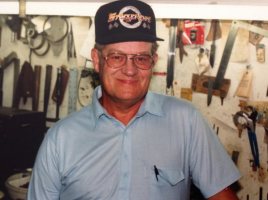 |
 |
 |
| Mike Leach |
Mike Leach in his shop |
Mike Leach soldering a guard |
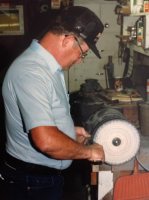 |
 |
 |
| Mike Leach buffing |
Mike Leach checking over his work |
Mike Leach with a beautiful knife he built |
William F. Moran Jr. or Bill Moran (May 1, 1925 - February 12, 2006) was a knifemaker legend who founded the American Bladesmith Society and reintroduced the process of making pattern welded steel to modern knife making. Moran's knives were sought after by celebrities and heads-of-state. The "William F. Moran School of Bladesmithing" bears his name and in addition to founding the ABS, he was a Blade Magazine Hall of Fame Member and a President of the Knifemakers' Guild. I spent a week in his shop in Frederick, Maryland in the fall of 1983 studying knifemaking. Here are some pictures of that time.
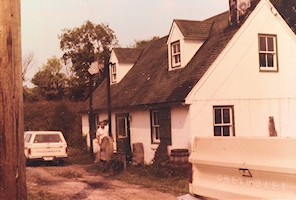 |
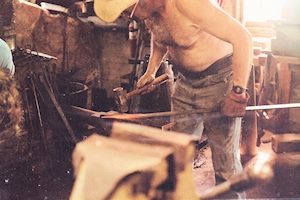 |
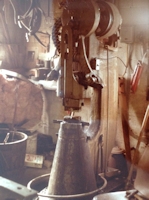 |
| Outside the Moran Knife Shop |
Bill Moran working in his shop |
Bill Moran's powerhammer |
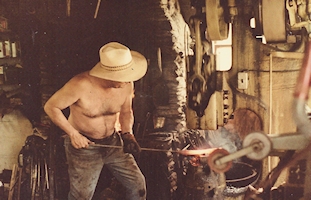 |
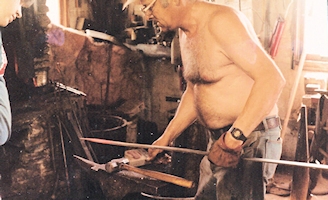 |
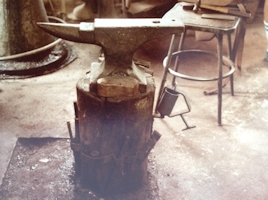 |
| Moran at his powerhammer |
Bill Moran |
Bill Moran's anvil |
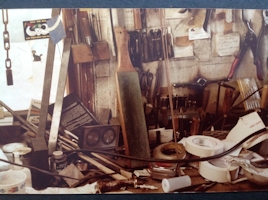 |
 |
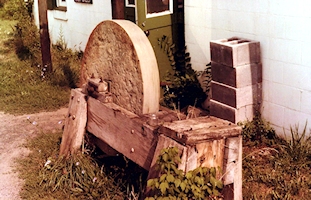 |
| The bench of Bill Moran |
The forge of Bill Moran |
Outside Bill Moran's shop |
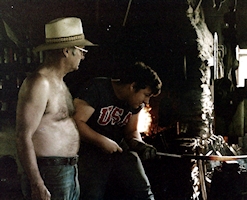 |
|
|
| Bill Moran teaching another student |
|
|
Corbet Sigman was a great knifemaker who was known for his exceptional attention to detail. He was also one of the kindest and most patient men I have ever met. Regretfully, Mr. Sigman passed away on August 5, 2006.
 |
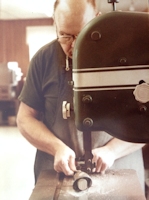 |
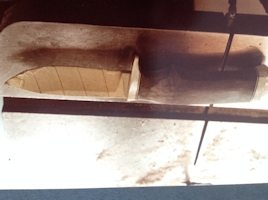 |
| Corbet Sigman 1983 |
Corbet Sigman 1983 |
Buffalo horn knife by Sigman |
 |
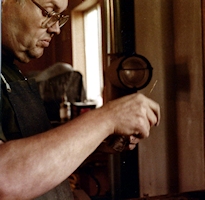 |
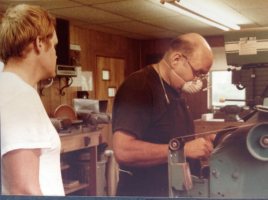 |
| Corbet R. Sigman |
Corbet R. Sigman |
I am watching Sigman |
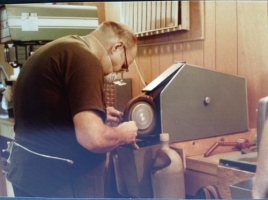 |
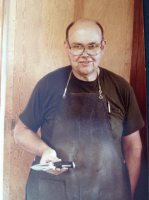 |
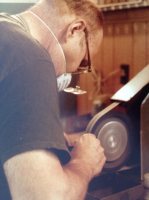 |
| Corbet Sigman at his Square Wheel grinder |
Corbet Sigman holding his buffalo horn knife |
Corbet Sigman grinding |
 |
 |
 |
| Corbet Sigman soldering a guard |
Corbet Sigman detailing |
Corbet Sigman gluing |
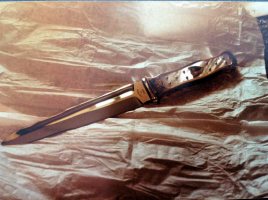 |
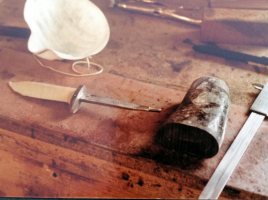 |
 |
| Knife by Corbet Sigman |
Corbet Sigman's project |
Corbet Sigman's shop |
|
